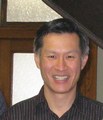GETTING AHEAD OF THE WAVE: Goal of the 2009 Comoax Valley Learning Lunch Seminar Series – raise awareness and create understanding of “An Integrated Wtershed Approach to Settlement”—because nature knows no boundaries

“We would like to shift the paradigm from boundaries to areas of commonality. The desired outcomes will include inter-departmental collaboration, inter-municipal sharing, and regional alignment. A key message is to view ‘planning’ not as land-zoning function but as a multi-faceted and iterative process that embraces the concept of truly integrated water-centric planning,” stated Derek Richmond. “We need to think of ourselves as a team, not as individuals within silos; getting there means we will have to break down boundaries through communication, collaboration, cooperation and coordination.”
2008 Vancouver Island Learning Lunch Seminar Series exceeds expectations for doing business differently

“Living Water Smart is a provincial strategy; we must look at it as a shared responsibility. Actually, it is not one strategy; the Province has a number of strategies. The Province is looking at raising the bar as far as what we are trying to accomplish with standards, provincial legislation and infrastructure grant programs, stated Glen Brown.
Real Estate Foundation hosts Green Developers Roundtable at 2008 Gaining Ground Summit
 “The roundtable purpose was to initiate a dialogue with the development community. This consultation is an essential element of a two-track approach to encourage local governments and the development community to implement policies and practices that accommodate settlement growth and change without irrevocable damage to the ecology that underlies the well being of Island communities,” reported John Finnie.
“The roundtable purpose was to initiate a dialogue with the development community. This consultation is an essential element of a two-track approach to encourage local governments and the development community to implement policies and practices that accommodate settlement growth and change without irrevocable damage to the ecology that underlies the well being of Island communities,” reported John Finnie.
Showcasing Green Infrastructure Innovation on Vancouver Island: Summary Report on the 2008 Capital Region Series
 “The goal in showcasing innovation and celebrating successes is to move ‘from awareness to action’ in doing business differently — through sharing of approaches, tools, experiences and lessons learned that will ultimately inform a pragmatic strategy for climate change adaptation,” states Eric Bonham, a founding member of the CAVI Leadership Team.
“The goal in showcasing innovation and celebrating successes is to move ‘from awareness to action’ in doing business differently — through sharing of approaches, tools, experiences and lessons learned that will ultimately inform a pragmatic strategy for climate change adaptation,” states Eric Bonham, a founding member of the CAVI Leadership Team.
Showcasing Green Infrastructure Innovation on Vancouver Island: The 2008 Capital Region Series
 “Showcasing Innovation has helped local government practitioners immeasurably by creating forums for them to share their experiences and lessons learned. This has created a ripple effect that has spurred even more innovation. The 2008 Series can play an integrating role to cut across disciplines and ultimately help communities create neighbourhoods that integrate both good planning and innovative engineering designs,” stated Ray Fung.
“Showcasing Innovation has helped local government practitioners immeasurably by creating forums for them to share their experiences and lessons learned. This has created a ripple effect that has spurred even more innovation. The 2008 Series can play an integrating role to cut across disciplines and ultimately help communities create neighbourhoods that integrate both good planning and innovative engineering designs,” stated Ray Fung.
SUMMARY REPORT ON 2008 COMOX VALLEY LEARNING LUNCH SEMINAR SERIES: “Create liveable communities AND protect stream health is the vision. To make it happen, a premise underpinning the series is that consistency in understanding of approaches and desired outcomes is best achieved by taking a professional development program into the places where local government practitioners work,” stated Kim Stephens, Water Sustainability Action Plan

“An action in Living Water Smart is that all land and water managers will know what makes a stream healthy, and therefore be able to help land and water users factor in new approaches to securing stream health and the full range of stream benefits. To that end, the Comox Valley series was conducted as a cumulative process, from philosophy to tools, in order to advance a regional team approach to rainwater management and green infrastructure. The desired outcome is that local government and private sector practitioners will make green choices that create liveable communities and protect stream health,” stated Kim Stephens.
TODAY’S EXPECTATIONS ARE TOMORROW’S STANDARDS – THEME FOR SEMINAR 1 OF INAUGURAL 2008 COMOX VALLEY LEARNING LUNCH SERIES: “In the last 15 to 20 years, we have seen dramatic changes in the Comox Valley in terms of land use; and rainwater effects on the environment have been dramatic,” stated Ian Whitehead when he provided context for evolution of engineering practices (September 2008)

A set of four presentations provided context for the day and set the scene for a walkabout through the Glacier View Pond area in East Courtenay. “The walkabout through the Glacier View Pond area provided an on-the-ground illustration of how the engineering approach to detention pond design has evolved in response to changing expectations,” stated Ian Whitehead in reflecting on changes in drainage practice he has implemented in East Courtenay over the past two decades.
LEGAL POLICIES AND STRATEGIES TO SUPPORT GREEN INFRASTRUCTURE – THEME FOR SEMINAR 2 OF INAUGURAL 2008 COMOX VALLEY LEARNING LUNCH SERIES: “The Inland Kenworth site on the Nanaimo Parkway at Northfield illustrated what can be accomplished through collaboration when a municipality establishes expectations and challenges a development proponent and design team to do business differently,” stated Kevin Lagan, Director of Public Works, City of Courtenay (October 2008)

The seminar introduced the extensive and very specific tools available to local government to manage the complete spectrum of rainfall events. “We structured the seminar in two parts: establishing expectations in order to influence the greening of the built environment; and delivering on expectations. Establishing expectations essentially means drawing a picture of what we want. Delivering on expectations means this is how we can and will get there,” stated Kevin Lagan.
NATURE KNOWS NO BOUNDARIES – THEME FOR SEMINAR 3 OF INAUGURAL 2008 COMOX VALLEY LEARNING LUNCH SERIES: “Use natural systems as your infrastructure,” urged Jack Minard, Executive Director, Comox Valley Land Trust, when he identified the steps in a Draft Workplan for a regional team approach to achieve the shared vision, namely: Create Liveable Communities and Protect Stream Health (November 2008)

“Nature has no borders; it does not recognize political or philosophical boundaries and it is essential for the health of human and non-human communities alike. To view nature in this way represents not a “special interest” approach but a modern advance in civil society. We are realizing that the current loss of ecosystems and biodiversity cannot continue, yet pressures to develop land for human use is placing huge demands on what remains,” stated Jack Minard.
RE-CAP FOR 2008 COMOX VALLEY LEARNING LUNCH SEMINAR SERIES: “There is a fundamental difference between outcome–oriented and output-oriented approaches to planning and engineering of municipal infrastructure. We are trying to change the way our communities look and feel,” stated Kim Stephens in his summation of the learning outcomes for all three seminars comprising the series

“The Learning Lunch Seminar Series is the first step in building a regional team approach so that there will be a common understanding and consistent messaging regarding on-the-ground expectations for rainwater management and green infrastructure. Looking back at my 35 years of experience, we have always been very good at planning; but we have difficulty going from planning to action. At the end of today, we want you to come out of here so inspired that you will actually do something, not just say that was a great day that we had,” stated Kim Stephens.

